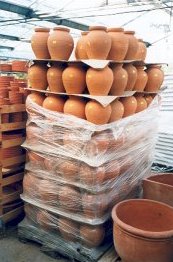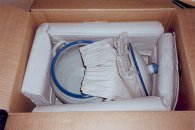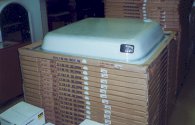Glass is a hard, brittle material which has solidified from a melt in amorphous form. Window glass is machine-produced flat glass with an unblemished surface in thicknesses of 0.8 - 7 mm; it is also known as sheet glass.
Porcelain is a ceramic material primarily produced from kaolin and is usually traded as fineware.
Enamel is a solidified vitreous layer of inorganic composition fused onto a substrate, preferably of ferrous metal. A distinction is drawn between sheet and cast enamel goods. Sheet enamel goods include household articles, wall cladding, signs, while bathtubs are an example of cast enamel goods.
Glass, porcelain and enamel goods do not contain any water, and belong in water content class 0 (WCC 0). However, packaging materials belonging to water content class 2 (WCC 2) may be used (cases, crates, cartons, with internal packing of wood wool, paper, PU and PE foams as films and chips) (see Figs. 189, 190, 191). These materials must be container dry, so as firstly not to cause mold growth due to the release of moisture into the enclosed microclimate of the standard container and secondly to retain their strength. These are accordingly goods which require particular humidity/moisture conditions (SC IV).
 Figure 189: Pallet with ceramic pots, protected with paperboard interlayers and wrapped in plastic film; Photo: Ragna Scharnow |
 Figure 190: Bread crock in a corrugated board carton lined with corrugated board spacers; Photo: Ragna Scharnow |
 Figure 191: Shower trays packaged in corrugated board interlayers with edge protectors |
Transport instructions and damage
Packaging to avoid breakage
Glass, porcelain and enamel goods are extremely fragile and so require particularly careful packaging.
Glass goods are packaged in cases using straw, wood wool or plastic foams. Window glass is best packaged in cases and/or in "A frames" which can be picked up on two or four sides by ground conveyors. Goods of large dimensions are packaged in crates or on frames, possibly using paper or plastic foams as separators between the individual sheets. Using inappropriate or no separators between the individual sheets results in scratching damage.
Porcelain articles should be wrapped in paper, wood wool or straw (N.B. hygroscopic) or packaged in plastic foams and are best transported in strong cases, for example made of wood.
Enamel goods also require careful packaging as the enamel coating can easily be chipped by mechanical influences. Good, strong internal padding is important. Relatively small articles are wrapped in paper and laid in cases which are padded with wood wool or plastic pellets; larger articles, especially the corners and edges, are secured with paper, straw or plastic pellets. Cases and crates should have good diagonal reinforcement and the walls should be sufficiently thick to prevent the contents from crushing. Crates should be of container "modular dimensions" so that they can be packed into containers with a tight fit. It is immaterial whether the tight fit in the container is achieved with just one case or crate or with several arranged side by side or one behind the other. Completely filling the container is the most effective way of securing the cargo and is especially preferred for such sensitive cargoes. Any remaining spaces must be filled.
Sensitivity to impact and jolting
Glass sheets should always be transported in a vertical position as they are more likely to break if stowed horizontally. Individual packages must be adequately marked with the symbols for fragile goods.
With enamel goods, a distinction should be drawn between flaking and chipping as causes of damage. "Flaking" is recognized in the enamel industry as a normal production defect, it being possible for small enamel parts to flake on exposure to low temperatures. "Chipping" due to impact, abrasion or other rough treatment of the enameled goods may result in losses.
Moisture
Although glass contains no water, it is sensitive to moisture. Depending upon a glass's resistance to moisture corrosion, i.e. to leaching of alkali metal oxides from the surface of the glass, it is assigned to one of five water resistance classes or hydrolysis classes. These hydrolysis classes are defined in German DIN standards and are tested using sulfuric or hydrochloric acid.
In one case, microscopes were transported in standard containers from a European port to Japan. On arrival, the lenses were found to have become cloudy due to the action of moisture. Investigations revealed that a fungal film had grown on them. Protection from all forms of moisture is thus required. Damage by microorganisms (microbial corrosion) depends upon the nature of the glass (acid class), the period of exposure to the microorganisms and the level of relative humidity (φ). At φ > 75% or in a condensing atmosphere, droplets or spots of a blue-black deposit form on optical products. At φ < 60%, the deposit is solid and can in most cases be removed by polishing.
One of the most dangerous kinds of deposit is the fungal film formed by fungal spores in a moist, warm environment at φ > 75%. During growth, fungal hyphae have a water content of greater than 90% and are moreover strongly hygroscopic. Excretion of acids results in clouding or dulling of lenses.
Fungal films form less readily on any kind of glass which has been treated with fungicides (heavy metal salts, mercury salts). Surfaces which have been subjected to fungal attack must be reground and polished, providing that thickness tolerances permit. Otherwise, the parts are unusable and must be replaced with others.